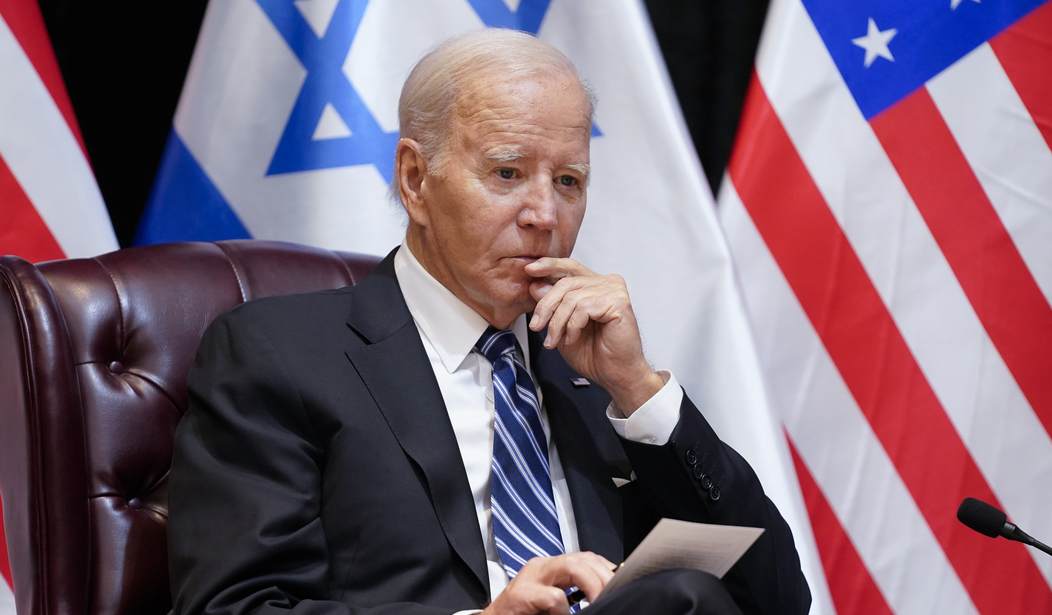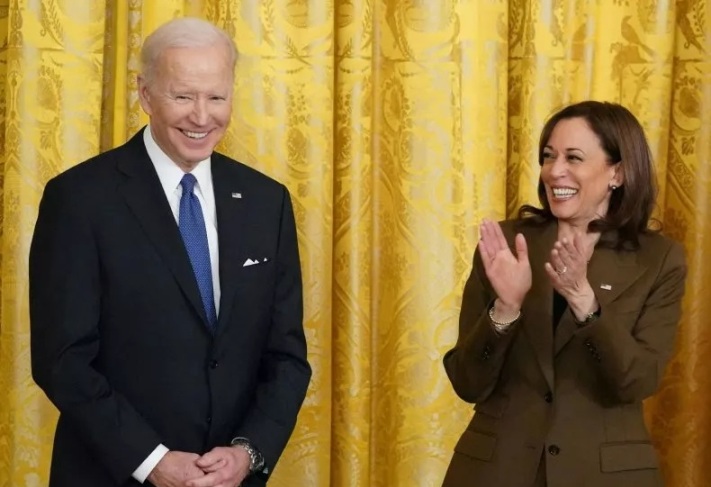| 9/14/2024: Senate's most vulnerable list still dominated by Democrats [Roll Call] | ||||||||||||||||||||||||||||||||||||||||||||||||||||||||||||||||||||||||||||||||||||||||||||||||||||||||||||||||||||||||||||||||||||||||||||||||||||||||||||||||||||||||||||||||||||||

Photo credit: Tom Williams/CQ Roll Call
The caption at rollcall.com which accompanies the above photo describes Senator Bob Casey, Jr. (D-PA) and his wife as they "celebrate on the final night of the Democratic National Convention". That's one grim-looking "celebration". It seems they aren't feeling the "joy" which, as you surely know by now, is one of the laughable emotional buzzwords that has been assigned to Queen Kamala's campaign by the gaslighting liberal media. It looks more like the Caseys are feeling a bit of constipation, and there's some chance they may get that sensation again in November, whenever Pennsylvania finally decides to stop vote-counting.

Photo credit: CNN
1. West Virginia

Photo credit: Fox News
2. Montana

Photo credit: AP News
At long last it appears that Tester's appeal has diminished to the point where he is in serious trouble. He may be in trouble in the polls, where surveys lately show Sheehy ahead by about 5 points, but if money alone determined the election outcome Tester would be winning in a landslide. As of the latest FEC filings, Tester has spent over $33 million as opposed to just over $10 million for Sheehy. As we have mentioned here on numerous occasions, there's not a House district or Senate seat in the U.S. where Democrats can't outspend Republicans by incredible margins if they want to. This will be proven to be true in almost every single hotly-contested Senate and House race in 2024.

Photo credit: 10TV
3. Ohio

Photo credit: WCPO
The 2022 Republican nominee, J.D. Vance, was (and still is) unacceptably conservative according to the wimpy wing of the Republican party, he had some trouble raising money and seemed to be off the air for long periods in the summer while Ryan was on the attack 24/7. Smelling blood in the water and sensing an unexpected pickup opportunity, Democrats flooded the state with oodles of cash and Ryan was able to outspend Vance by the margin of $57 million to $15 million. After trailing most of the time, finally in October Vance consistently pulled ahead in the polls and then won in November, but it was uncomfortably close in supposedly "dark red" Ohio.

Photo credit: Ohio Star
The 2024 Republican nominee, Bernie Moreno, is unacceptably conservative according to the wimpy wing of the Republican party, he has had some trouble raising money and seemed to be off the air for long periods in the summer while Brown was on the attack 24/7. Democrats flooded the state with oodles of cash and Brown has so far been able to outspend Moreno by the margin of $43 million to $11 million. After trailing the entire time, finally in September Moreno appears to be closing the gap in the polls, but has yet to be shown in the lead in any poll. Will "dark red" Ohio come through for Moreno, with Trump dragging him across the finish line?

Photo credit: Market Realist
4. Michigan

Photo credit: Rogers for Senate
Stabenow's replacement in the 8th congressional district in 2000 was Republican Mike Rogers -- the same guy who is now trying to replace her in the Senate in 2024. Rogers, who was at the time a Michigan state senator, defeated fellow state senator Dianne Byrum in 2000 by just 160 votes out of nearly 300,000. Rogers campaigned as a moderate and was even able to obtain some endorsements from Democrat politicians.

Photo credit: CNN
It was Elissa Slotkin -- the "former" Deep State operative who is now the Democrat nominee for the 2024 Senate race against Mike Rogers. 
Photo credit: Lancaster Online
5. Pennsylvania

Photo credit: Dave McCormick PA
Casey's (the Junior one) challenger this year is Dave McCormick. McCormick spent lavishly of his own money in the 2022 Republican primary vs. "Electable" Dr. Oz, but lost by less than 1,000 votes out of 1.34 million which were cast. McCormick graciously conceded and now has returned for another shot at the Senate -- this time with the GOP field cleared for him; no more dealing with pesky moderate dilettantes like Oz or staunch conservatives like Kathy Barnette. McCormick is again funding a large part ($4 million as of late June) of his own campaign and, aside from a recent left-biased outlier poll from CBS, appears to be inching closer to a possible -- but still unlikely -- upset.
Other states which could have close Senate elections:
Conclusion: The most likely scenario is that the Republicans will have a net gain of 1 or 2 seats in the Senate. If they win West Virginia and Montana but nothing more, and do not lose Florida or Texas, that will be a pretty good election night at the Senate level. But we'll still have people wailing and being bitterly disappointed in positive developments -- just like they were in 2022 -- because their greedy expectation of "muh red wayve" didn't come true and Santa didn't leave everything they wished for under the Christmas tree. Tags:
2024
Senate
Montana
Ohio
Michigan
Pennsylvania
| ||||||||||||||||||||||||||||||||||||||||||||||||||||||||||||||||||||||||||||||||||||||||||||||||||||||||||||||||||||||||||||||||||||||||||||||||||||||||||||||||||||||||||||||||||||||
| 7/13/2024: The "Keystone" For the 2024 Presidential Election, or "Everything You Always Wanted to Know About Pennsylvania But Were Afraid to Ask" [RightDataUSA] | ||||||||||||||||||||||||||||||||||||||||||||||||||||||||||||||||||||||||||||||||||||||||||||||||||||||||||||||||||||||||||||||||||||||||||||||||||||||||||||||||||||||||||||||||||||||
If the polls are even close to being accurate, the outcome of the 2024 presidential election is going to be determined by the results in just six states: Arizona, Georgia, Michigan, Nevada, Pennsylvania and Wisconsin. These are often referred to as the "swing" states. North Carolina isn't on that list, but probably should be; folks on the right like to pretend it's a 1000% mortal lock for the GOP, but it's not. It just leans slightly in the direction of Republicans at the presidential level in recent years.

2024 presidential election map; swing states in purple
If the Democrat candidate, whoever it turns out to be, wins every state that Democrats normally win, he/she/it will receive 226 electoral votes (EV) from California, Colorado, Connecticut, Delaware, District of Columbia, Hawaii, Illinois, Maine*, Maryland, Massachusetts, Minnesota, New Hampshire, New Jersey, New Mexico, New York, Oregon, Rhode Island, Vermont, Virginia and Washington.
Assuming everything else goes as expected, Trump needs 35 EV from those six states in order to win; the Democrat nominee needs at least 44. 
2020 presidential election results in PA
Pennsylvania has been reliably Democrat presidentially from 1992 to the present with the exception of 2016 when overconfident Democrats just barely failed to manufacture enough votes in the Philadelphia ghetto to deprive Donald Trump from eking out a statewide win by 0.7%. Trump would have won the presidency even without PA's 20 electoral votes that year, but Democrats still rued their mistake and vowed it would not happen again in 2020. It didn't.
2024 scenarios: If Trump wins all of the states which Republicans usually win these days, he needs only Georgia and Pennsylvania among the six swing states and the result is a 270-268 win. 
Trump 270, Democrat 268
If Trump loses PA, then he still loses even if he takes both Arizona and Nevada along with Georgia (268-270).

Democrat 270, Trump 268 (and now that one Nebraska electoral vote looks huge)
Wisconsin likely isn't going to Trump (current illusions aside), what with the Wisconsin Democrat Supreme Court recently issuing a ruling which trashes the election integrity measures passed by the state legislature, and practically mandates Democrat vote fraud. Correspondingly, any delusionals who are dreaming about a GOP Senate pickup in WI can wake up now and face reality unless some 1994-ish tidal wave hits in November.
The stakes are too high to simply fold up and wait for some other year, as they did in the days of Walter Mondale, George McGovern and Mike Dukakis. Not this time. Not when the GOP nominee is Donald Trump, a man who deranged leftists believe is "literally Hitler". And not with control of the House and Senate so much up-for-grabs. In 1972, 1984 and 1988 Democrats knew with 100% certainty that they would maintain House control irrespective of the presidential outcome; they also had the Senate in their pockets for two of those three election years. Memo to GOP cheerleaders: become overconfident at your own idiotic risk. The last Democrat to win the White House without PA was Harry Truman in 1948. George W. Bush was twice elected president without PA, in 2000 and 2004. Richard Nixon accomplished the same thing in 1968 though he and George Wallace combined for 52.4% of the vote in Pennsylvania. Bellwether status: only three times since 1948 has PA's voting percentage for the GOP presidential candidate varied by more than about 2% from the national average. Two of those years were 1988 and 1984, when longtime Democrat steel-mill towns in southwestern PA, which had begun dying well before Reagan ever took office, swung hard to the left against Reagan anyway. The Pittsburgh metropolitan area was the only one of any significant size in the entire country where Reagan's percentage of the vote declined from 1980 to 1984. Bush was able to amass enough electoral votes elsewhere that he did not need the Keystone State in '00 and '04. As it turned out, Trump didn't need it in 2016 either -- but he almost certainly does now. 2000 presidential election results
In 2000, Dubya won several states which are no longer normally winnable for the GOP in a presidential election -- Colorado and Virginia being the biggest of those. In 2000 CO and VA, plus Nevada and New Hampshire, added 29 electoral votes to the GOP total, more than offsetting the absence of PA's 23 EV. Bush of course also won as expected in Arizona and Georgia, which were solid Republican properties at that time but are now rightfully considered swing states. Bush did lose Iowa which is now considered true-blue (proper color usage). Bush won by a total of 5 EV that year, 271 to 266.
2004 presidential election results
In 2004 Bush repeated his victories in VA + CO and picked up Iowa and New Mexico but dropped New Hampshire. The outcome in the electoral college wasn't nearly as close as it had been four years earlier. The final score was: Bush 286, Lurch 251. The major Rust Belt states of Pennsylvania, Michigan and Wisconsin once again were not needed.
We have divided the commonwealth of Pennsylvania into seven sectors which are analyzed below, in order of their size and political impact, from smallest to largest. 
Photo credit: visiterie.com
Erie sector (Erie County):

Photo credit: govtech.com
Wilkes-Barre/Scranton sector (Lackawanna and Luzerne counties):

Photo credit: visithersheyharrisburg.org
Harrisburg-Lebanon-York sector (Cumberland, Dauphin, Lebanon and York counties):

Photo credit: amishfarmandhouse.com
Reading-Lancaster-Allentown sector (Berks, Carbon, Lancaster, Lehigh and Northampton counties):

Photo credit: wellsboropa.com
Non-metro sector, i.e. "The T":

Photo credit: Richard Nowitz / visitpittsburgh.com
Pittsburgh sector (Allegheny, Armstrong, Beaver, Butler, Fayette, Greene, Washington and Westmoreland counties):
Blinded by their ancestral loyalty to the Democrat party, the Bitter Clingers voted for Obama anyway that November. But as in northeastern PA, when Obama's Environmental Protection Agency declared "War on Coal", the blinders were finally removed and many of these voters were through with the Democrat party once and for all. It sure took long enough. All through the FDR years, the Pittsburgh sector voted more Democrat than any other sector in the state. Even for several decades after FDR finally perished, the voters of southwestern PA remained attached to his Welfare State programs and their descendants. Pittsburgh didn't like Ike in '52 and voted for Egghead Adlai; naturally the heavily-Catholic ethnic voters of the region (like the ones in northeast PA) strongly preferred their co-religionist in 1960. Pittsburgh was the most anti-Nixon (36.7%) of all PA sectors in 1968 -- and the most pro-George Wallace (10.6%). It was the only Pennsylvania sector to vote against Ronald Reagan in 1980 and as mentioned previously was the only significant metro area in the entire U.S. to move further left during Reagan's 1984 demolition of hapless Fritz Mondale. Speaking of hapless, Mike Dukakis achieved 59% of the Pittsburgh sector's vote in 1988, a far greater percentage than the intrepid Tank Commander received in any other portion of PA. During the 1990s Pittsburgh was overtaken by the Philadelphia metro area as being the most liberal in the state, but southwestern PA still gave solid -- though decreasing -- margins to Democrats from 1992 through 2008. By the early 2000s the Steel City area was the most marginal in Pennsylvania, with the potential to tilt either way though it still leaned slightly to the left in presidential elections. By 2012, the effects of Obama's "War on Coal" were evident and the areas of the country which still depended on coal for what little economic vitality they had, finally rebelled at the ballot box. From eastern and southern Ohio, through small-town western Pennsylvania, all of West Virginia, eastern Kentucky and southwestern Virginia, long-time reflexive Democrat voters began trending Republican in large numbers. 
The media and other Democrats will always use urban ghetto and barrio areas as examples of woeful "poverty" because it suits their racist anti-White agenda -- but if you ever want to see real poverty in America, look to the areas of Appalachia mentioned in the last paragraph. They were poor to begin with and now have been further impoverished by Democrat political policies.

Photo credit: Thom Carroll / phillyvoice.com
Philadelphia sector (Bucks, Chester, Delaware, Montgomery and Philadelphia counties):

Photo credit: AP / Denis Paquin
The real "reaction" was against the fact that the GOP was now being led by House Speaker Newt Gingrich and like-minded conservatives -- and therefore was viewed by the left-wingnuts of BOTH parties as being racists, rednecks, sexists, Bible-thumpers, illiterate trailer-trash, etc. This was no longer the party of moderate milquetoasts like former House Minority Leader Bob Michel. Republicans finally had some power in Washington after four dark decades and -- gasp! -- they might actually try to use that power!
As of the early ("pre-Gingrich") 1990s the country club suburbs were still comfortably Republican in terms of registrations but not always in terms of their presidential voting. In 1992, Bill and Hillary defeated George Bush by the slender margin of 39.9% to 39.7% in the suburban ring around Philly. Aside from the Goldwater year, this was the first time ever for those counties as a whole to vote Democrat for president. While some deterioration was clearly already taking place as of 1992, the area's leftward lurch gained serious traction after 1994. Dole's losing margin in 1996 was 4.6 points, Dubya was defeated by 5.3% in 2000 and then by 7.1% in 2004. Things got much worse in 2008, and they haven't improved since that time: 2008: Obama +15.5% 2012: Obama +9.7% 2016: Hillary +13.9% 2020: Biden +18.9%
Remember, all of the above data is for the Philadelphia suburbs only and contains no part of the city.
Voter registrations are, much more often than not, lagging indicators of an area's voting preference; the trend is evident at the ballot box before it shows up in head counts of party membership. That is because voting is an immediate reaction to a political situation, whereas party membership is part of a voter's identity. Registration statistics in the Philly sector belatedly confirmed the movement which was already being seen in the election data. These liberal Republicans perhaps hoped that the GOP's unpalatable (though mostly infinitesimal) move toward the right would cease, and the party would "come back to them". Maybe that was why there was no great rush by suburban Philadelphia voters to abandon the GOP and re-register as Democrats immediately after 1994. In 1994 there were about 341,000 more Republicans than Democrats here, and that margin actually increased to nearly 368,000 as of 1996. Even by 2000, as Albert Einstein Gore was winning the Philly suburbs, GOP registrations in Bucks, ChesCo, DelCo and MontCo still outnumbered Democrats by almost 350,000. Then the mass exodus from the GOP began, with more and more liberal Republicans completing their journey to the Far Left and officially becoming registered Democrats. As of 2004 the Republican advantage had been reduced to 245,000 and just four years later it was down to practically zero. This movement was not solely caused by new Democrats invading the suburbs, fresh from the Philly ghetto and other places. As Democrat registrations blossomed, the GOP head count was dropping precipitously, whether from party switches or because Republican voters were fleeing these suburbs altogether. By 2009, Democrats had the bigger numbers and the trend is only lately slowing -- but not reversing. In November of 2020, Democrats were +158,000 in voter registrations here; as of July, 2024 the number stands at +163,000. Registration totals are not just trivial factoids, because these days ballots are the important thing; every registered voter represents a "ballot", whether the voter casts that ballot or not. If he doesn't, the ballot can still be "harvested" after election day by (Democrat) party operatives. And that ballot, even if fraudulently completed, counts every bit as much as legitimate votes do. If GOP vote-counters in some tiny Podunk Republican county wished to commit fraud, their ability to do so is very limited because that tiny county has so few registered voters, i.e. so few possible BALLOTS. However, when Democrat vote counters in large metropolitan counties choose to commit fraud on behalf of their party, the number of BALLOTS they can harvest -- whether by pretending to contact persons who did not vote, or by simply scanning the same Democrat ballots again and again -- is virtually unlimited by comparison to what a tiny Republican county could do. Trump lost the Philadelphia suburbs by almost 300,000 votes in 2020; he lost the inner-city of Philadelphia by another 470,000. He is likely to do about the same in those places, if not worse, in 2024. That's a lot of votes -- over three-quarters of a million -- to make up in the rest of this politically marginal state. Polls currently suggest that Trump may be able to pull it off. But polls aren't ballots. 
Photo credit: Charles Fox / Philadelphia Inquirer
Before we close, there is one other factor to consider regarding elections in Pennsylvania:
Tags: | ||||||||||||||||||||||||||||||||||||||||||||||||||||||||||||||||||||||||||||||||||||||||||||||||||||||||||||||||||||||||||||||||||||||||||||||||||||||||||||||||||||||||||||||||||||||
| 4/24/2024: [Pennsylvania] 2024 Primary Election Recap [RightDataUSA] | ||||||||||||||||||||||||||||||||||||||||||||||||||||||||||||||||||||||||||||||||||||||||||||||||||||||||||||||||||||||||||||||||||||||||||||||||||||||||||||||||||||||||||||||||||||||
Here is a review of everything important which happened in the Pennsylvania primaries yesterday. 
Photo credit: Philadelphia Inquirer / Patel campaign
The highest-profile Democrat primary in PA took place in the Democrat-gerrymandered 12th congressional district, where terrorist-supporting liberal racist Summer Lee was challenged by a slightly less liberal racist Democrat named Bhavini Patel. Lee didn't bother to campaign much at all (and now we know why) but Patel did. Aside from a minor disagreement on the subject of Israel, Patel tried to stress to her potential primary voters that she was just as hate-filled toward all the "right" things as Lee is. Despite her somnambulant campaign, Lee still outspent Patel by nearly 3:1 according to FEC data from early April, and won by about 20 points.  Photo credit: Bill Kalina, The York Dispatch That is Pennsylvania's 10th congressional district -- the reprehensible shithole of Harrisburg, the city of York which isn't a whole lot better, and formerly-nice but rapidly deteriorating Cumberland County in between -- where liberal candidates were crawling over each other in their attempt to be "king of the hill" in the Democrat primary and have the honor of taking on embattled conservative Scott Perry in November. CD-10 contains enough good suburban and rural territory that it counterbalances the Harrisburg and York ghetto vote and the liberal college punkie vote in Carlisle -- but the balance is precarious and getting less favorable every day. The district was heavily gerrymandered by the Pennsylvania Democrat Supreme Court when it trashed the state's entire district map in 2018, and a specific effort was made to "get" Perry from that point forward. He has managed to survive despite that effort, sometimes just barely. Democrats are going all-out this year and will spend as much as it takes; on the other hand Perry has relatively little cash on hand for such a well-entrenched and threatened incumbent. Perry's status in Congress is unique in one respect -- east of Ohio and north of the Mason-Dixon line there is exactly one conservative Republican in the U.S. House: Scott Perry. An unabashed Trump supporter in addition to his reliable conservatism, Perry routinely causes crazed liberals to foam at the mouth. And not just liberals in the Democrat party; the liberal (money-controlling) wing of the GOP is no fan of Perry either, and there is only scant evidence of the party's support for Perry in 2024 so far. Perry faced no primary opposition, which is good since he can hardly afford it. The winner of the Rat primary was, as expected, Janelle Stelson, a "bubble headed bleach blonde" talking head from a local Harrisburg TV station. Stelson wasn't quite the wealthiest Democrat running in the primary field of 6; that was Mike O'Brien, a left-winger claiming to be a "patriot" who ran on his military record. O'Brien was trounced by nearly a 2:1 margin, finishing a distant second. This was always the likeliest outcome; in recent years the Democrat primary electorate nearly always adheres to the diktats of political correctness. Given two candidates with similar leftist credentials and the same mandatory hatreds, female always outranks male, black always outranks White, etc. Sorry, Mikey. If you're not openly gay or a transvestite (and maybe even if you are), you're second-class here. In any event, the only patriot who was ever in this race is Scott Perry, and he's going to need a lot of help to not only overcome the usual Democrat $$$ advantages, but also to get his message out and overcome the relentlessly negative/biased media coverage from Stelson's allies in the Harrisburg, York and Carlisle areas. Along with the national media, which has made it a priority to help the Democrats pick up this House seat. Unlike Pennsylvania's CD-12 which is a pipe dream for the GOP, this district really is a battleground and there are at least 20 others just like it nationwide. These districts have Republican incumbents who are running for re-election, and who are in for the fight of their lives. Some ignorant observers believe that the supposed plethora of open Republican seats will be the ones which are going to be lost and therefore would be the districts responsible for the upcoming loss of House control. That is patently false. Control of the House will be decided first and foremost in these battleground districts rather than the open GOP districts, and both parties know it. The Democrats clearly do, as evidenced by all of the money being funneled into them. Further down the ballot at the state legislative level, there was some good news for both parties. In House District 50, GOP incumbent Bud Cook fended off a challenge from Stephanie Waggett. Cook, a mostly conservative representative, was accused of "having a problem with how he treats women" so Waggett changed her party affiliation from Democrat to Republican to oppose Cook. She appears to have lost by a wide margin, and the Democrats did not run a candidate in this GOP-leaning district. In the extremely solid 80th District, incumbent moderate Republican Jim Gregory was defeated. Gregory crawled into bed with Democrats in 2023 to thwart legislation which would have enhanced desperately-needed election integrity measures in PA by requiring voter ID. The GOP primary race in the 117th District (Wilkes-Barre suburbs) is still too close to call, but incumbent liberal Republican Michael Cabell was trailing by a very small amount on the morning after the primary. Cabell raised over 5 times as much money as his challenger but hopefully will end up losing anyway.  Photo credit: glensidelocal.com But the biggest winners at the state House level were the Democrats, who audibly sighed with relief at the results of the district 172 primary, in which mentally diseased liberal representative Kevin Boyle was running for re-election. In 2021, Boyle was arrested on charges of harassment and violating a protection from abuse (PFA) order. Two months ago, Boyle was drunk off his overprivileged ass in a Philadelphia bar shortly after midnight and played the "don't you know who the f--- I am?!?" card (a direct quote, actually) when asked nicely to leave. This servant of the people then threatened to use his political influence to have the bar closed forever and threatened to assault the female employees. He emerged from that episode unscathed in exactly the same way that no Republican ever would, but just as the limited furor over that incident had passed, a warrant was issued for Boyle's arrest for violating his PFA. According to an article posted on the "PA Townhall.com" website, the warrant came following "weeks of escalating public outbursts from the state lawmaker, whose deteriorating mental state forced Democratic leadership to rescind his committee chairmanship". Democrats have allowed Boyle to vote remotely on legislation despite his status as a fugitive. Boyle's vote is important given the narrow 102-100 margin the Rats have recently had in the PA House. [The margin is now 102-101 after the GOP easily won a special election yesterday in the 139th District, making Boyle's continued participation from his undisclosed hideout even more critical to Democrats.] Like any other arrogant Democrat politician/criminal, Boyle figures he's above the law. And he has good reason to think so -- because he is. Not only is nothing happening regarding his alcohol-fueled activities from February, but just one day before the primary, hyper-partisan Democrat Philly D.A. Larry Krasner suddenly withdrew the arrest warrant which had been issued on Boyle. The D.A. lamely asserted that there was a "piece missing" in the case, that piece apparently being the fact that Boyle is not a Republican. Which means the two-tiered "justice" system works in his favor instead of against him, as Dirty Larry has ensured. Boyle still lost yesterday, as most Democrats hoped he would. If he hadn't, Republicans would've been handed a golden opportunity to pick up the seat in November. District 172 should be at least somewhat marginal, but it normally favors Democrats pretty heavily these days. If Boyle had won, his own party was preparing to create a law which would allow them to expel him; then there would have been a quickie special election, a new Democrat elected in Boyle's place, and the seat would have been salvaged for November. This was the same logic which impelled the Republicans to eject conservative freshman George Santos from the U.S. House, but the Stupid Party neglected to take into account the leftward lean of Santos' district and the major funding advantage Democrats always have in competitive districts, and so they threw away the seat needlessly. But at least they got rid of a conservative, so it wasn't a total loss for the RINOs! Tags: | ||||||||||||||||||||||||||||||||||||||||||||||||||||||||||||||||||||||||||||||||||||||||||||||||||||||||||||||||||||||||||||||||||||||||||||||||||||||||||||||||||||||||||||||||||||||
| 1/4/2024: [Pennsylvania] It's not just Trump: Democrats are moving to bar Republicans from ballots nationwide [NY Post] | ||||||||||||||||||||||||||||||||||||||||||||||||||||||||||||||||||||||||||||||||||||||||||||||||||||||||||||||||||||||||||||||||||||||||||||||||||||||||||||||||||||||||||||||||||||||

Photo credit: thetimes-tribune.com
We've referenced Scott Perry (R-PA) before as someone who is a prime target of left-wing hatred and someone whom liberals would dearly love to exterminate from Congress in 2024 [see commentary posted here 10 months ago] -- by any means possible. The haters have noticed by now that the hyper-partisan Democrat gerrymander which was implemented on their behalf in Pennsylvania in 2018 in violation of existing state law isn't working as intended in this case (though it worked perfectly in numerous other districts in PA). Perry is still in Congress and has been re-elected three times since the Democrat gerrymanders went into effect. Tags:
U.S. House
2024
Pennsylvania
Scott Perry
Lawfare
| ||||||||||||||||||||||||||||||||||||||||||||||||||||||||||||||||||||||||||||||||||||||||||||||||||||||||||||||||||||||||||||||||||||||||||||||||||||||||||||||||||||||||||||||||||||||
| 10/28/2023: Masks Off: Alarming New Gallup Poll Blows Growing Democrat Schism Over the Israel Issue Wide Open [Redstate] | ||||||||||||||||||||||||||||||||||||||||||||||||||||||||||||||||||||||||||||||||||||||||||||||||||||||||||||||||||||||||||||||||||||||||||||||||||||||||||||||||||||||||||||||||||||||

Photo credit: AP Photo/Evan Vucci
Fifteen Democrats went on record as failing to support Israel after the Hamas attacks, when asked to vote on a resolution comdemning those attacks. The 9 who voted against the resolution are: Tags:
Israel
Hamas
Democrat
Terrorists
U.S. House
Pennsylvania
Pittsburgh
| ||||||||||||||||||||||||||||||||||||||||||||||||||||||||||||||||||||||||||||||||||||||||||||||||||||||||||||||||||||||||||||||||||||||||||||||||||||||||||||||||||||||||||||||||||||||
| 7/27/2022: Democrats Favored to Win Senate for First Time as Polling Improves: 538 [Newsweek (LOL)] | ||||||||||||||||||||||||||||||||||||||||||||||||||||||||||||||||||||||||||||||||||||||||||||||||||||||||||||||||||||||||||||||||||||||||||||||||||||||||||||||||||||||||||||||||||||||

Photo credit: Getty Images
The leftists at 538 are only just now realizing that Democrats are favored to keep the Senate? Oz is toast in PA and always was, so that's minus-1 for the GOP and the loss is not likely to be offset with a Walker victory in Georgia which was supposed to be (and may still be) the most likely Republican pickup. But "most likely" still doesn't mean "likely" whatsoever. Assuming all other incumbents win too and open seats are held, that means a 51-49 Senate with the GOP on the short end. Tags:
Senate
2022
Democrats retain control
Pennsylvania
Georgia
| ||||||||||||||||||||||||||||||||||||||||||||||||||||||||||||||||||||||||||||||||||||||||||||||||||||||||||||||||||||||||||||||||||||||||||||||||||||||||||||||||||||||||||||||||||||||